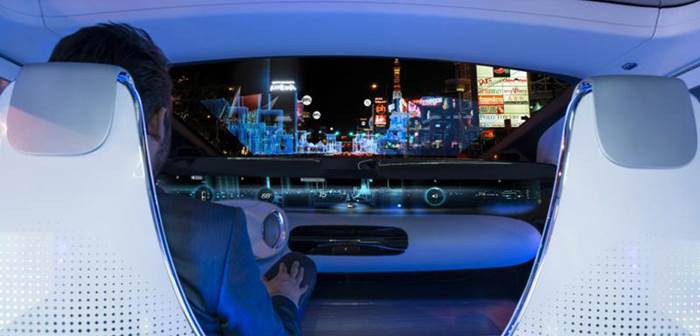Each year, automotive presence at CES grows and it has become a key fixture in the motor-show calendar, demonstrated by dozens of manufacturers and hundreds of vehicle tech-related exhibitors present.
Technology is enabling some game-changing opportunities and the overwhelming buzzword this year was AI – which was delivered through many guises, including voice control, virtual assistants, autonomous driving and mobility solutions.
Voice control & virtual assistants
This year, Amazon’s Alexa was ubiquitous… hugely popular in 2016 (as a standalone), the integration with countless other products & services meant there was a constant stream of new and exciting updates…
Ford announced that it will introduce Alexa into its cars, enabling consumers to give voice commands through the dashboard console (such as add items to shopping lists or control Alexa-enabled smart home devices). In addition, the integration with the car’s navigation system also turns Alexa into a concierge-style source of restaurants, points of interest, petrol stations, shops and more.
Similarly, Nissan and BMW announced their integration, instead using Microsoft’s Cortana as part of their “Connected Vehicle Vision” – the integration with Azure (Cloud Computing) and Office 365 suite, will be of particular interest to businessmen/women.
Toyota took things one step further with Concept-i, and their own bespoke AI agent called “Yui”. Moving beyond a question-and-answer assistant, Yui is supposedly capable of reading human emotions with the ability to interpret a driver’s emotions and habits, communicating via in-car lighting, sound and touch.
Autonomous driving & mobility
Many manufacturers were keen to demonstrate their own emission-free, fully-connected vision of autonomous driving. Hyundai (Ioniq), BMW (e5 series) and Ford (Fusion Hybrid) offered CES patrons (incident free) rides up and down The Strip, dispelling consumer pessimism around convenience and safety.
Mercedes-Benz and Audi both offered further insight into their partnership with tech giant NVidia, announcing additional features of its in-car computing, including “Co-Pilot” – a system that uses facial recognition and gaze tracking to help improve safety on the roads. The NVidia team is ambitious in terms of its timeline, with the aim of getting Level 4 autonomy (full self-driving, with manual driving options) market ready by 2020.
Taking AI one step further was Honda’s NeuV (“nee-vee”). At its heart is “HANA” (Honda’s Automated Network Assistant), to help personalise the driving experience. However, a new carpooling opportunity presented significant benefits for would-be owners… when the car is not in use, the electric vehicle is plugged into an autonomous-ride sharing fleet, thereby generating revenue for the owner, when other people “rent” the car. Additionally, the NeuV is also able to recoup costs by managing power consumption from the grid, monitoring electricity rates and charging only when it’s cost-effective to do so (as well as selling surplus energy back to the grid – think of the NeuV like its own electricity market AI economies trader!).
AI arms race
Much of the work showcased by auto brands leaned heavily on the behaviours and trends that we currently experience in our everyday lives.
There’s currently an AI arms race, with Alexa, Cortana, Google Assistant, Siri and Viv, all vying for a greater share of the market. In such a fragmented space, each of the big players has certain advantages – Amazon has strong consumer data; Microsoft has enterprise advantages; Google has Search/Email data; Apple has smartphone penetration; Samsung/Viv have strong home-appliance coverage. Even at this early stage, the automotive sector has become fragmented with the variety of integrations across the tech landscape…
Thus the adoption of voice controls and internet integration into cars is a logical extension of our everyday lives, designed to deliver greater convenience – the convenience of alerting you to nearby petrol stations if fuel is low, or to ping you certain points of interest during the weekend, based on your location proximity and designated interests/hobbies.
Could this give rise to new types of media opportunities?
Perhaps the potential for brands to ‘engage’ with a cars’ virtual assistant based on the owner/passengers behavioural, demographic, interest and geo-location data. For example, Starbucks could serve advertising offers to drivers on their morning communicate, who are in close proximity to a participating outlet.
Another trend that has emerged in recent years – especially for the next generation of ‘car buyers’ aka millennials – is the ‘sharing economy’ or ‘collaborative consumption’. Whilst some brands were conceived out of this car-club culture shift (ZipCar, DriveNow, UberPOOL), it’s the auto manufacturers who for a time, were set to lose out. Hence the move from some manufacturers (Ford, BMW, Honda, GM and so on) to integrate car ownership and rental opportunities, thereby generating revenue for owners. On the face of it, this vision of mobility satisfies all: manufacturers sell more cars, owners recoup money mitigating their car’s depreciating value and non-owners reap the benefits of increased peer-to-peer rental schemes available.
We have seen unprecedented growth in the UK automotive market over the past few years. But, the SMMT predict car sales to slow in 2017, and the full impact of Brexit is not yet understood.
Whilst it’s too early to suggest that a ‘sharing economy’ could destabilise the status quo of traditional car ownership – ‘mobility’ is taking on many different forms. It’s also growing rapidly – predicted to be worth €13Bn by 2020 (Europe), and thus has significant implications for the future car market.
Judging by CES 2017, consensus remains that the future of cars is an autonomous world. However, as manufacturers navigate their path to this goal, consumers are, for the moment, being soothed with smaller-scale advancements that extend the benefits of their day-to-day lives outside their car, into their car.




